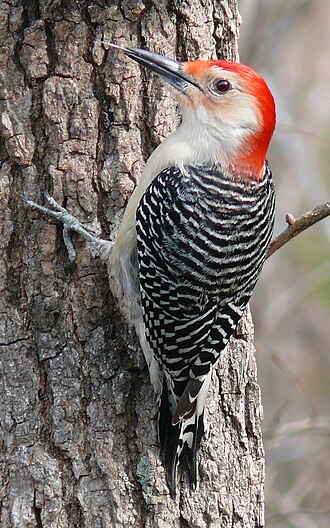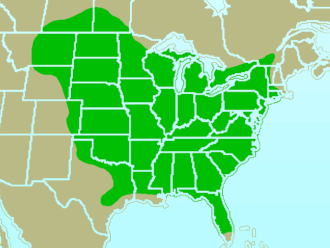Difference between revisions of "Field Guide/Birds/Melanerpes carolinus"
m (- Category of AYHAB) |
|||
| (7 intermediate revisions by one other user not shown) | |||
| Line 1: | Line 1: | ||
| − | {{ | + | {{Bird id |
| − | |||
| name = Red-bellied Woodpecker | | name = Red-bellied Woodpecker | ||
| − | | | + | | latin_name = Melanerpes carolinus |
| − | | | + | | level = 4 |
| − | | | + | | image_1 = Red-bellied Woodpecker-27527.jpg |
| − | + | | caption_1 = Red-bellied oodpecker | |
| − | |||
| − | |||
| − | |||
| − | |||
| − | |||
| − | |||
| − | |||
| − | |||
| range_map = Red-bellied Woodpecker-rangemap.gif | | range_map = Red-bellied Woodpecker-rangemap.gif | ||
| − | | | + | | description = The '''Red-bellied Woodpecker''', ''Melanerpes carolinus'', is a medium-sized woodpecker. |
| − | |||
| − | |||
| − | The '''Red-bellied Woodpecker''', ''Melanerpes carolinus'', is a medium-sized | ||
Adults are mainly light grey on the face and underparts; they have black and white barred patterns on their back, wings and tail. Adult males have a red cap going from the bill to the nape; females have a red patch on the nape and another above the bill. The reddish tinge on the belly that gives the bird its name is difficult to see in field identification. They are 9 to 10.5 inches long, and have a wingspan of 15 to 18 inches. | Adults are mainly light grey on the face and underparts; they have black and white barred patterns on their back, wings and tail. Adult males have a red cap going from the bill to the nape; females have a red patch on the nape and another above the bill. The reddish tinge on the belly that gives the bird its name is difficult to see in field identification. They are 9 to 10.5 inches long, and have a wingspan of 15 to 18 inches. | ||
| − | Their breeding habitat is usually | + | Their breeding habitat is usually deciduous forests in southern Canada and the northeastern United States, however they may range as far south as Florida and as far west as Texas. They nest in the decayed cavities of dead trees, old stumps, or in live trees that have softer wood such as elms, maples, or willows; both sexes assist in digging nesting cavities. |
| − | These birds search out insects on tree trunks. They may also catch | + | These birds search out insects on tree trunks. They may also catch insects in flight. They are omnivores, eating insects, fruits, nuts and seeds. |
| − | Red-bellied woodpeckers are noisy birds, and have many varies | + | Red-bellied woodpeckers are noisy birds, and have many varies calls. Calls have been described as sounding like ''"churr-churr-churr"'' or ''"chuf-chuf-chuf"'' with an alternating ''"br-r-r-r-t"'' sound. Males tend to call and drum more frequently than females, but both sexes call. |
| − | + | Red-bellied woodpeckers are attracted to noises that resonate. They tap noisily on aluminum roofs, metal guttering and even on cars to attract mates. Their annoying sound can cause dismay to a person who wishes to sleep peacefully at night. | |
| − | Red-bellied woodpeckers are attracted to noises that resonate. They tap noisily on aluminum roofs, metal guttering and even on cars to attract mates. Their annoying sound can cause dismay to a person who wishes to sleep peacefully at night. | + | |call = Red-bellied Woodpecker.ogg |
| − | + | }} | |
| − | |||
| − | |||
| − | |||
| − | |||
| − | |||
| − | |||
| − | |||
| − | |||
| − | |||
| − | |||
| − | |||
| − | |||
| − | |||
| − | |||
| − | |||
| − | |||
| − | |||
| − | |||
| − | |||
| − | |||
| − | |||
| − | |||
| − | |||
| − | |||
| − | |||
| − | |||
| − | |||
| − | |||
| − | |||
| − | |||
| − | |||
| − | |||
| − | |||
| − | |||
Latest revision as of 02:52, 15 July 2022
| Melanerpes carolinus (Red-bellied Woodpecker) | |
|---|---|
| Description | |
| The Red-bellied Woodpecker, Melanerpes carolinus, is a medium-sized woodpecker.
Adults are mainly light grey on the face and underparts; they have black and white barred patterns on their back, wings and tail. Adult males have a red cap going from the bill to the nape; females have a red patch on the nape and another above the bill. The reddish tinge on the belly that gives the bird its name is difficult to see in field identification. They are 9 to 10.5 inches long, and have a wingspan of 15 to 18 inches. Their breeding habitat is usually deciduous forests in southern Canada and the northeastern United States, however they may range as far south as Florida and as far west as Texas. They nest in the decayed cavities of dead trees, old stumps, or in live trees that have softer wood such as elms, maples, or willows; both sexes assist in digging nesting cavities. These birds search out insects on tree trunks. They may also catch insects in flight. They are omnivores, eating insects, fruits, nuts and seeds. Red-bellied woodpeckers are noisy birds, and have many varies calls. Calls have been described as sounding like "churr-churr-churr" or "chuf-chuf-chuf" with an alternating "br-r-r-r-t" sound. Males tend to call and drum more frequently than females, but both sexes call. Red-bellied woodpeckers are attracted to noises that resonate. They tap noisily on aluminum roofs, metal guttering and even on cars to attract mates. Their annoying sound can cause dismay to a person who wishes to sleep peacefully at night. | |


